牛津译林版(2019)选择性必修第一册Unit 1 Food matters Integrated skills & Extending reading课件(共42张PPT)
文档属性
| 名称 | 牛津译林版(2019)选择性必修第一册Unit 1 Food matters Integrated skills & Extending reading课件(共42张PPT) | 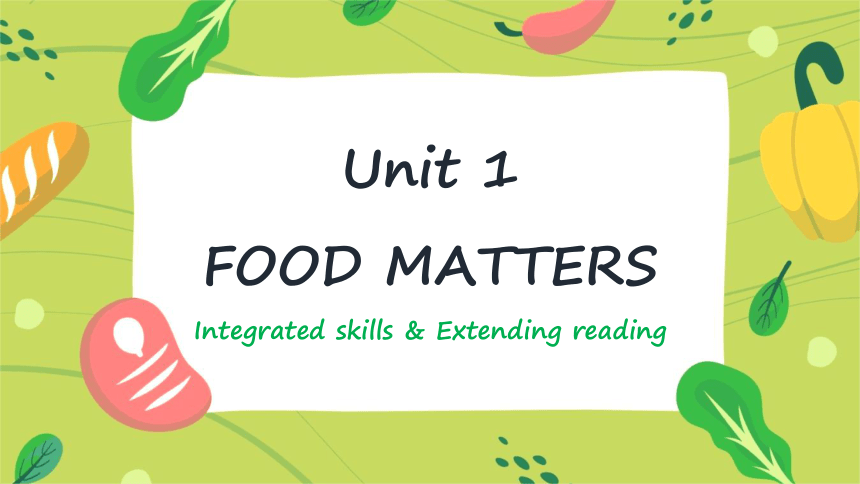 | |
| 格式 | pptx | ||
| 文件大小 | 82.6MB | ||
| 资源类型 | 教案 | ||
| 版本资源 | 牛津译林版(2019) | ||
| 科目 | 英语 | ||
| 更新时间 | 2024-07-18 21:42:04 | ||
图片预览

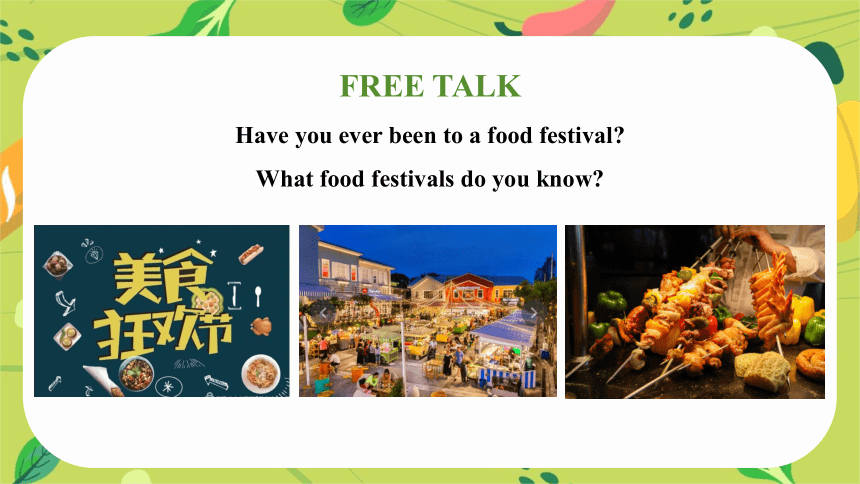
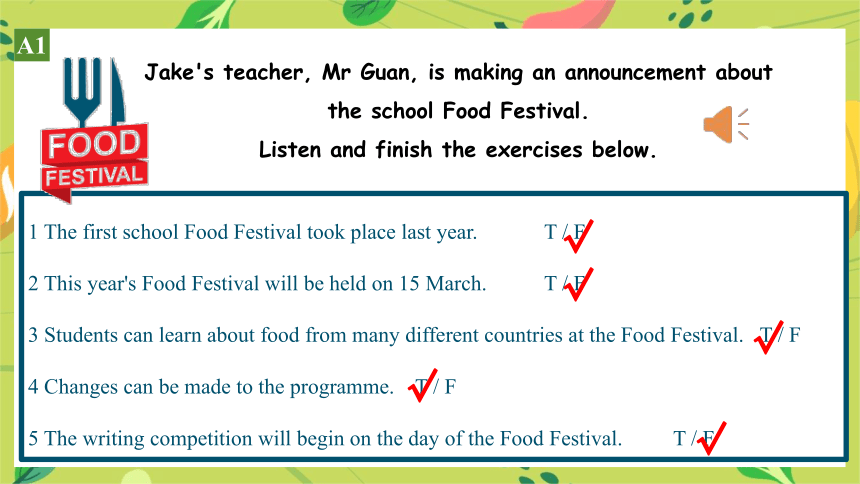
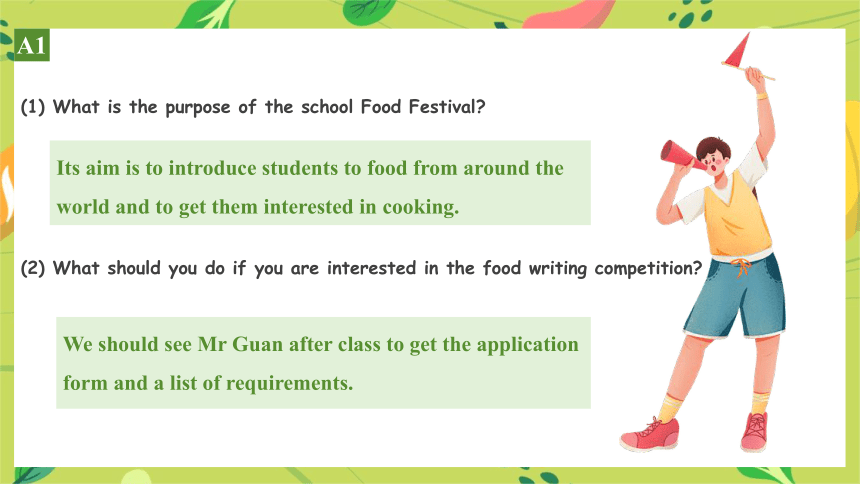
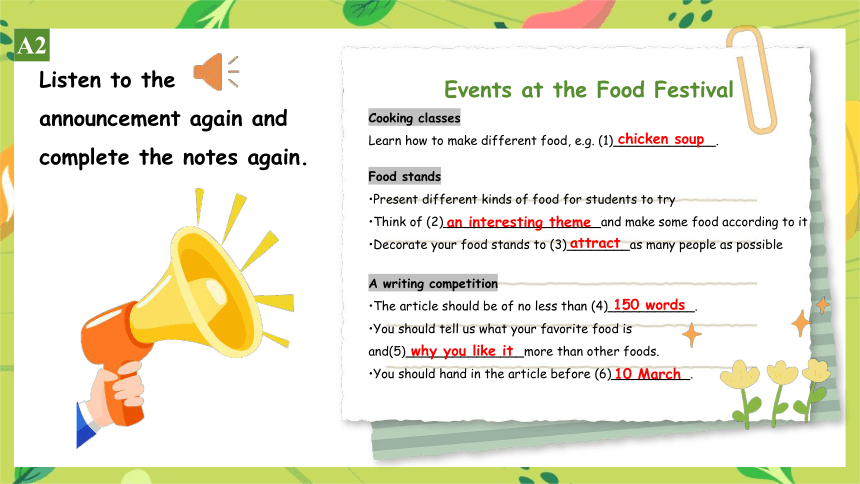
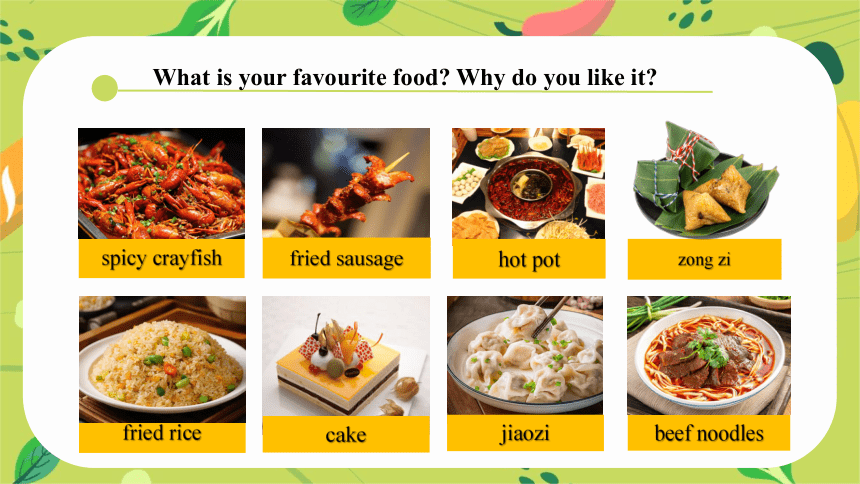
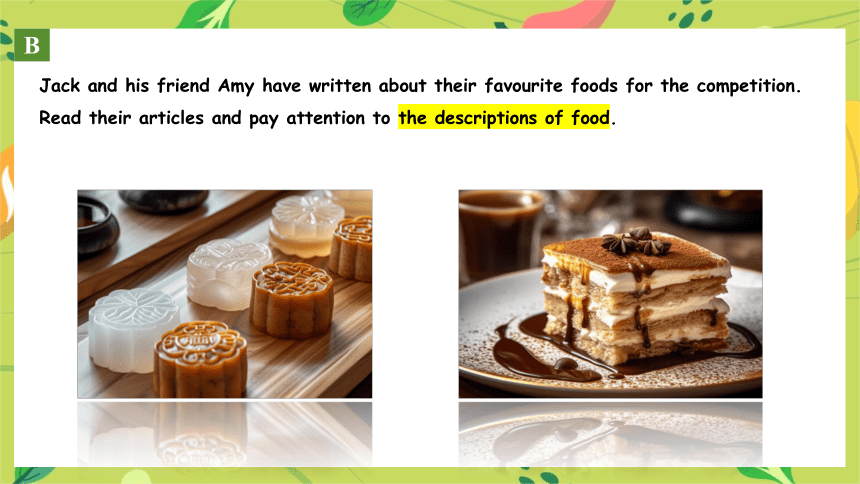
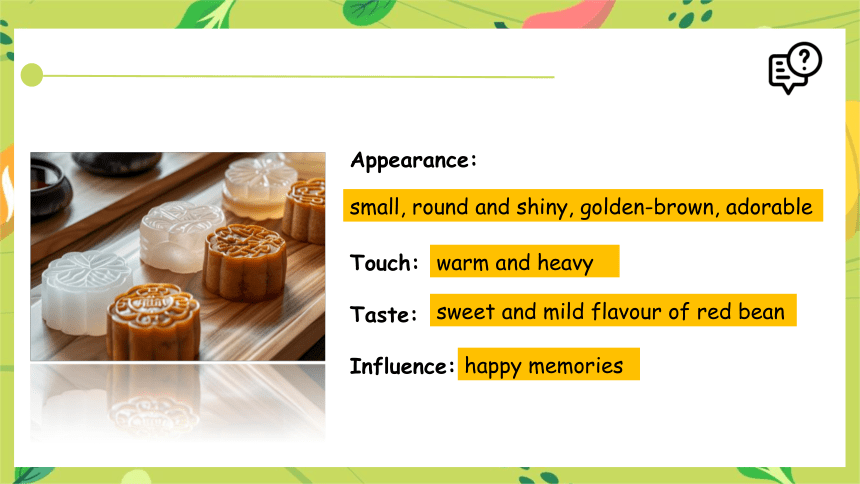
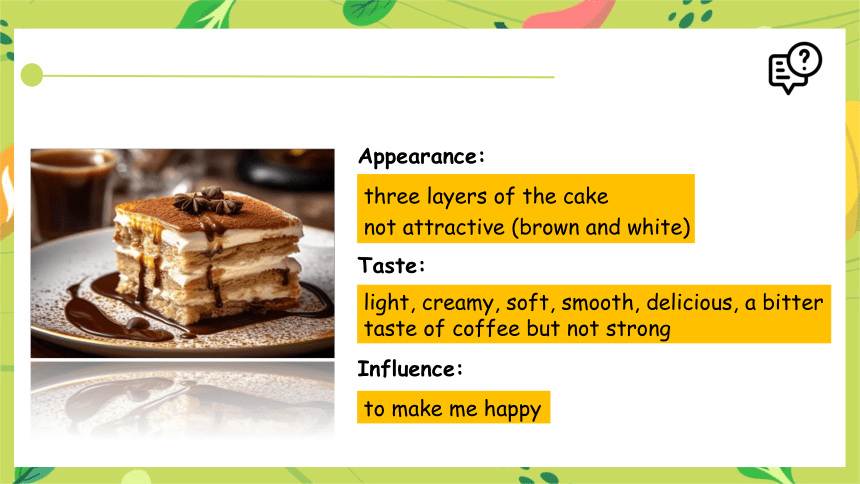
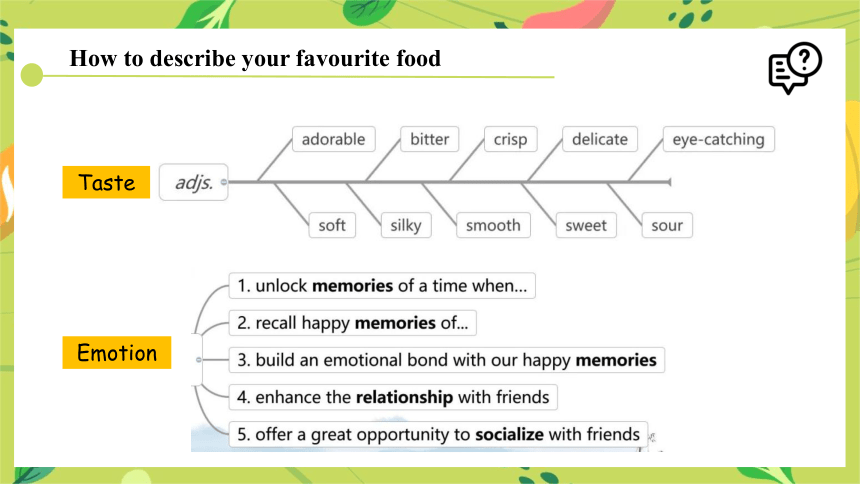
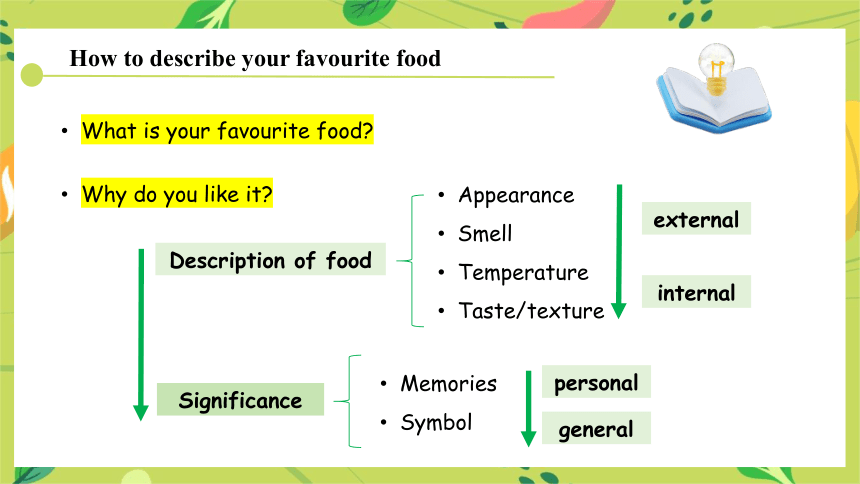
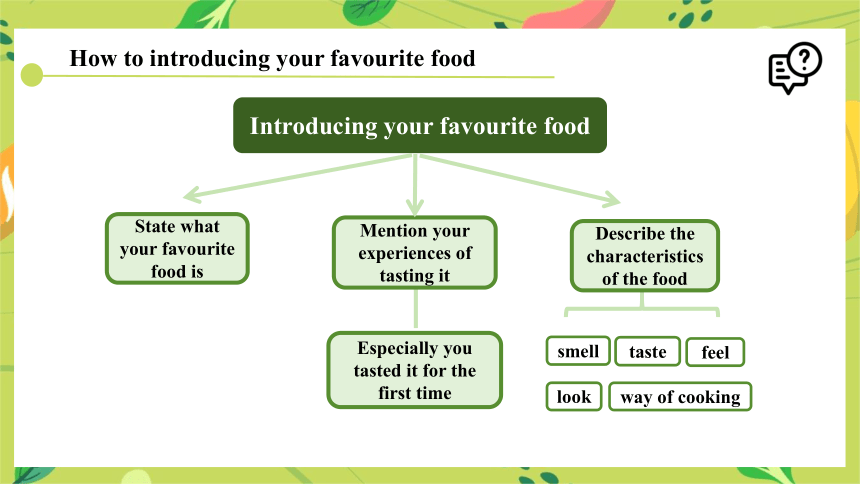
文档简介
(共42张PPT)
Unit 1
FOOD MATTERS
Integrated skills & Extending reading
FREE TALK
Have you ever been to a food festival
What food festivals do you know
Jake's teacher, Mr Guan, is making an announcement about the school Food Festival.
Listen and finish the exercises below.
1 The first school Food Festival took place last year. T / F
2 This year's Food Festival will be held on 15 March. T / F
3 Students can learn about food from many different countries at the Food Festival. T / F
4 Changes can be made to the programme. T / F
5 The writing competition will begin on the day of the Food Festival. T / F
√
√
√
√
√
A1
A1
(1) What is the purpose of the school Food Festival
(2) What should you do if you are interested in the food writing competition
Its aim is to introduce students to food from around the world and to get them interested in cooking.
We should see Mr Guan after class to get the application form and a list of requirements.
Events at the Food Festival
Cooking classes
Learn how to make different food, e.g. (1)_____________.
Food stands
Present different kinds of food for students to try
Think of (2)____________________and make some food according to it
Decorate your food stands to (3)________as many people as possible
A writing competition
The article should be of no less than (4)___________.
You should tell us what your favorite food is and(5)_______________more than other foods.
You should hand in the article before (6)__________.
Listen to the announcement again and complete the notes again.
chicken soup
an interesting theme
attract
150 words
why you like it
10 March
A2
What is your favourite food Why do you like it
fried rice
fried sausage
spicy crayfish
zong zi
cake
beef noodles
jiaozi
hot pot
Jack and his friend Amy have written about their favourite foods for the competition.
Read their articles and pay attention to the descriptions of food.
B
Appearance:
Touch:
Taste:
Influence:
small, round and shiny, golden-brown, adorable
warm and heavy
sweet and mild flavour of red bean
happy memories
Appearance:
Taste:
Influence:
three layers of the cake
not attractive (brown and white)
light, creamy, soft, smooth, delicious, a bitter taste of coffee but not strong
to make me happy
How to describe your favourite food
Taste
Emotion
How to describe your favourite food
Why do you like it
Description of food
Significance
Appearance
Smell
Temperature
Taste/texture
external
internal
Memories
Symbol
personal
general
What is your favourite food
How to introducing your favourite food
Introducing your favourite food
State what your favourite food is
Describe the characteristics of the food
Especially you tasted it for the first time
look
Mention your experiences of tasting it
smell
taste
feel
way of cooking
Shape: round, square, circle, oval, rectangle, triangle, meniscus, angular ...
Colour: red, green, yellow, pink, black, white, golden-brown, shiny ...
Size: small, big, large, medium, average ...
Language expression-appearance
WRITING
Language expression-smell
Language expression-temperature
WRITING
Language expression-taste
Language expression-taste
READING
WRITING
Using rhetorical questions in conversation rhetorical question is a figure of speech in the form of a question that is asked to emphasize a point or to express feelings and attitudes.
For example, when you ask "How can I forget such a tasty dish ", you are actually emphasizing that you always remember the dish.
WRITING
Write an article about your favourite food.
Use your ideas from part C and the information in parts A and B to help you.
Planning your writing
Learning about the text type
An article about your favourite food is a piece of descriptive writing which can create a vivid picture in readers’ minds through plenty of sensory details.
WRITING
Planning your writing
Learning about the structure
State clearly what your favourite food it.
Mention your experiences of tasting it, especially for the first time.
Describe the characteristics of the food.
Lead in the main topic directly
Linking to the significance and scene
Details
WRITING
Planning your writing
Learning about the language
When you describe food, you can use adjectives to create an image of the food in the mind of the reader. Adjectives commonly used to describe food include smelly, bitter, sweet, salty, juicy, creamy...
Vivid and impressive, attract readers to have a try, arouse readers’ common sense
WRITING
Now start your writing.
WRITING
WRITING
Checking your writing
Remember to check your writing after you finish and exchange drafts between you and your partner. Pay attention to the following aspects:
□ Punctuation □ Spelling □ Grammar
□ Choice of words □ Style (formal/informal) □ Structure
WRITING
Checking your writing
Self-review
Do you use adjectives to describe the food Is your description vivid enough
What changes can you make to improve your writing
Peer review
Does your partner think there are enough sensory details in your writing
Which part does your partner find most interesting
My favourite food—zongzi
My favourite food is a popular Chinese dish—zongzi, which is usualy served during the Dragon Boat Festival. Zongzi is iike a pyramid-shaped dumpling. This tasty dish is made of rice and wrapped in bamboo or reed leaves to give it a special flavour,lt consists of meat, peanut, egg yolk or other fillings. I still remember the moment when I made zongzi with my family members, which was a cherished one. Most people still maintain the tradition of eating zongzi on the day of the Dragon Boat Pestival. However, the special delicacy has become so popular that you can now buy if al the year round.
Sample
Do you know the three traditional Chinese foods
Sichuan hot pot
Nanjing salted duck
Cantonese dim sum
Read the entries from the blog of a food critic who is eating his way through traditional Chinese food.
7 March, Sichuan hot pot ________ experience
________
________ for his favor
12 August, _________________ ________ experience
_______ to make salted duck
________
8 December, ________________ _________
_____ the Cantonese have their breakfast
Dishes
Nanjing salted duck
Cantonese dim sum
Personal
History
Reasons
Personal
Ways
History
History
Ways
Read para.1 and find the adjectives the author uses to describe the features of the hot pot.
___________________ hot pot;
________flavor (spicy 辛辣的)
______________layer of chillies …
__________meat,fish and vegetables
What are the functions of these adjectives
These adjectives make the description of the foods more expressive(有表现力的)and ________(生动的)so as to ________________(注入活力) the words.
mouth-watering
hot
beautiful
fresh
vivid
breathe life into
Read para.2 and answer the following questions.
When did Sichuan hot pots start off
What does the writer love the most about Sichuan hot pots
They are believed to start off in the late Qing Dynasty.
What the writer loves the most about Sichuan hot pots
is that ___________________________________________
_________________________________________________
they offer a great opportunity to socialize with friends since a meal can last for hours.
Brief introduction: impact, effect
Personal experience: progress, way to eat, features
History: how it to be invented, development
The reason why he likes it: social meal
Brief introduction: impact
Feature: taste, how to cook
Personal experience
History:
how and why it to be invented (past)
Impact (present)
Shows his love
Brief introduction: daily
History
Present situation
Ways of making it
Shows his love
Cantonese dim sum was first served with tea in the mid-19th century and eating dim sum with tea has become an essentialpart of the daily routine for people in Guangzhou.
It consists of a variety of small dishes cooked in various ways such asbaking, boiling, steaming or frying.
There are over a thousand different dishes to try, and for hours, the locals drink tea, chat with each other, and enjoy the wide selection of dishes.
History
What it is
The way of making it
WRITE A SUMMARY
WRITE A SUMMARY
How to introduce food
History, development
Features
Popularity
Ways of cooking or making
Why does the writer base his personal experiences when introducing the traditional food
What dish is popular in your hometown
Introduce it to a foreign traveller.
Explain its popularity, history and features.
Vocabulary
1. expand
expand…into… 把……扩展成……
expand into… 扩大成为……
expand on/upon sth.详述/充分叙述/详细阐明某事
练习:Could you __________ on that point, please
expand
Vocabulary
2. appetite
have a good/poor/no appetite 胃口好/胃口不好/没有胃口
develop an appetite for. . . 对……提起胃口
ruin one's appetite 破坏某人的食欲
lose one's appetite 某人失去胃口
an appetite for. . . 对……的喜爱/强烈欲望
练习:The walk gave me a good ________.
appetite
Vocabulary
3. emphasis
lay/put/place emphasis on... 强调/重视……
emphasise(同emphasize) vt.强调,重视,着重
emphasise the importance of... 强调……的重要性
练习:Too much ___________ is placed on research.
emphasis
Vocabulary
4. essential
essentially adv.本质上,根本上
be essential for/to… 对……来说是极为重要的
It is essential (for sb.) to do sth. (对某人来说)做某事是完全必要的
It is essential that… ……是必要/至关重要的
(that 从句要用虚拟语气,即从句谓语用“should+动词原形”的形式,should可省略)
练习:It is essential that students __________ (get) themselves prepared for the coming future.
(should) get
Vocabulary
5. estimate
It is estimated (that)... 据估计……
be estimated to be/have/cost sth. 被估计为/有/价值……
estimate sth. at... 估计某物为……
a rough estimate 粗略的估计
练习:Over a third of the population is estimated ___________ (have) no access to the health service now.
to have
Review the language points and complete the exercises.
Homework
See you next class!
Unit 1
FOOD MATTERS
Integrated skills & Extending reading
FREE TALK
Have you ever been to a food festival
What food festivals do you know
Jake's teacher, Mr Guan, is making an announcement about the school Food Festival.
Listen and finish the exercises below.
1 The first school Food Festival took place last year. T / F
2 This year's Food Festival will be held on 15 March. T / F
3 Students can learn about food from many different countries at the Food Festival. T / F
4 Changes can be made to the programme. T / F
5 The writing competition will begin on the day of the Food Festival. T / F
√
√
√
√
√
A1
A1
(1) What is the purpose of the school Food Festival
(2) What should you do if you are interested in the food writing competition
Its aim is to introduce students to food from around the world and to get them interested in cooking.
We should see Mr Guan after class to get the application form and a list of requirements.
Events at the Food Festival
Cooking classes
Learn how to make different food, e.g. (1)_____________.
Food stands
Present different kinds of food for students to try
Think of (2)____________________and make some food according to it
Decorate your food stands to (3)________as many people as possible
A writing competition
The article should be of no less than (4)___________.
You should tell us what your favorite food is and(5)_______________more than other foods.
You should hand in the article before (6)__________.
Listen to the announcement again and complete the notes again.
chicken soup
an interesting theme
attract
150 words
why you like it
10 March
A2
What is your favourite food Why do you like it
fried rice
fried sausage
spicy crayfish
zong zi
cake
beef noodles
jiaozi
hot pot
Jack and his friend Amy have written about their favourite foods for the competition.
Read their articles and pay attention to the descriptions of food.
B
Appearance:
Touch:
Taste:
Influence:
small, round and shiny, golden-brown, adorable
warm and heavy
sweet and mild flavour of red bean
happy memories
Appearance:
Taste:
Influence:
three layers of the cake
not attractive (brown and white)
light, creamy, soft, smooth, delicious, a bitter taste of coffee but not strong
to make me happy
How to describe your favourite food
Taste
Emotion
How to describe your favourite food
Why do you like it
Description of food
Significance
Appearance
Smell
Temperature
Taste/texture
external
internal
Memories
Symbol
personal
general
What is your favourite food
How to introducing your favourite food
Introducing your favourite food
State what your favourite food is
Describe the characteristics of the food
Especially you tasted it for the first time
look
Mention your experiences of tasting it
smell
taste
feel
way of cooking
Shape: round, square, circle, oval, rectangle, triangle, meniscus, angular ...
Colour: red, green, yellow, pink, black, white, golden-brown, shiny ...
Size: small, big, large, medium, average ...
Language expression-appearance
WRITING
Language expression-smell
Language expression-temperature
WRITING
Language expression-taste
Language expression-taste
READING
WRITING
Using rhetorical questions in conversation rhetorical question is a figure of speech in the form of a question that is asked to emphasize a point or to express feelings and attitudes.
For example, when you ask "How can I forget such a tasty dish ", you are actually emphasizing that you always remember the dish.
WRITING
Write an article about your favourite food.
Use your ideas from part C and the information in parts A and B to help you.
Planning your writing
Learning about the text type
An article about your favourite food is a piece of descriptive writing which can create a vivid picture in readers’ minds through plenty of sensory details.
WRITING
Planning your writing
Learning about the structure
State clearly what your favourite food it.
Mention your experiences of tasting it, especially for the first time.
Describe the characteristics of the food.
Lead in the main topic directly
Linking to the significance and scene
Details
WRITING
Planning your writing
Learning about the language
When you describe food, you can use adjectives to create an image of the food in the mind of the reader. Adjectives commonly used to describe food include smelly, bitter, sweet, salty, juicy, creamy...
Vivid and impressive, attract readers to have a try, arouse readers’ common sense
WRITING
Now start your writing.
WRITING
WRITING
Checking your writing
Remember to check your writing after you finish and exchange drafts between you and your partner. Pay attention to the following aspects:
□ Punctuation □ Spelling □ Grammar
□ Choice of words □ Style (formal/informal) □ Structure
WRITING
Checking your writing
Self-review
Do you use adjectives to describe the food Is your description vivid enough
What changes can you make to improve your writing
Peer review
Does your partner think there are enough sensory details in your writing
Which part does your partner find most interesting
My favourite food—zongzi
My favourite food is a popular Chinese dish—zongzi, which is usualy served during the Dragon Boat Festival. Zongzi is iike a pyramid-shaped dumpling. This tasty dish is made of rice and wrapped in bamboo or reed leaves to give it a special flavour,lt consists of meat, peanut, egg yolk or other fillings. I still remember the moment when I made zongzi with my family members, which was a cherished one. Most people still maintain the tradition of eating zongzi on the day of the Dragon Boat Pestival. However, the special delicacy has become so popular that you can now buy if al the year round.
Sample
Do you know the three traditional Chinese foods
Sichuan hot pot
Nanjing salted duck
Cantonese dim sum
Read the entries from the blog of a food critic who is eating his way through traditional Chinese food.
7 March, Sichuan hot pot ________ experience
________
________ for his favor
12 August, _________________ ________ experience
_______ to make salted duck
________
8 December, ________________ _________
_____ the Cantonese have their breakfast
Dishes
Nanjing salted duck
Cantonese dim sum
Personal
History
Reasons
Personal
Ways
History
History
Ways
Read para.1 and find the adjectives the author uses to describe the features of the hot pot.
___________________ hot pot;
________flavor (spicy 辛辣的)
______________layer of chillies …
__________meat,fish and vegetables
What are the functions of these adjectives
These adjectives make the description of the foods more expressive(有表现力的)and ________(生动的)so as to ________________(注入活力) the words.
mouth-watering
hot
beautiful
fresh
vivid
breathe life into
Read para.2 and answer the following questions.
When did Sichuan hot pots start off
What does the writer love the most about Sichuan hot pots
They are believed to start off in the late Qing Dynasty.
What the writer loves the most about Sichuan hot pots
is that ___________________________________________
_________________________________________________
they offer a great opportunity to socialize with friends since a meal can last for hours.
Brief introduction: impact, effect
Personal experience: progress, way to eat, features
History: how it to be invented, development
The reason why he likes it: social meal
Brief introduction: impact
Feature: taste, how to cook
Personal experience
History:
how and why it to be invented (past)
Impact (present)
Shows his love
Brief introduction: daily
History
Present situation
Ways of making it
Shows his love
Cantonese dim sum was first served with tea in the mid-19th century and eating dim sum with tea has become an essentialpart of the daily routine for people in Guangzhou.
It consists of a variety of small dishes cooked in various ways such asbaking, boiling, steaming or frying.
There are over a thousand different dishes to try, and for hours, the locals drink tea, chat with each other, and enjoy the wide selection of dishes.
History
What it is
The way of making it
WRITE A SUMMARY
WRITE A SUMMARY
How to introduce food
History, development
Features
Popularity
Ways of cooking or making
Why does the writer base his personal experiences when introducing the traditional food
What dish is popular in your hometown
Introduce it to a foreign traveller.
Explain its popularity, history and features.
Vocabulary
1. expand
expand…into… 把……扩展成……
expand into… 扩大成为……
expand on/upon sth.详述/充分叙述/详细阐明某事
练习:Could you __________ on that point, please
expand
Vocabulary
2. appetite
have a good/poor/no appetite 胃口好/胃口不好/没有胃口
develop an appetite for. . . 对……提起胃口
ruin one's appetite 破坏某人的食欲
lose one's appetite 某人失去胃口
an appetite for. . . 对……的喜爱/强烈欲望
练习:The walk gave me a good ________.
appetite
Vocabulary
3. emphasis
lay/put/place emphasis on... 强调/重视……
emphasise(同emphasize) vt.强调,重视,着重
emphasise the importance of... 强调……的重要性
练习:Too much ___________ is placed on research.
emphasis
Vocabulary
4. essential
essentially adv.本质上,根本上
be essential for/to… 对……来说是极为重要的
It is essential (for sb.) to do sth. (对某人来说)做某事是完全必要的
It is essential that… ……是必要/至关重要的
(that 从句要用虚拟语气,即从句谓语用“should+动词原形”的形式,should可省略)
练习:It is essential that students __________ (get) themselves prepared for the coming future.
(should) get
Vocabulary
5. estimate
It is estimated (that)... 据估计……
be estimated to be/have/cost sth. 被估计为/有/价值……
estimate sth. at... 估计某物为……
a rough estimate 粗略的估计
练习:Over a third of the population is estimated ___________ (have) no access to the health service now.
to have
Review the language points and complete the exercises.
Homework
See you next class!
同课章节目录
- Unit 1 Food matters
- Welcome to the unit
- Reading
- Grammar and usage
- Integrated skills
- Extended reading
- Project
- Unit 2 The Universal Language
- Welcome to the unit
- Reading
- Grammar and usage
- Integrated skills
- Extended reading
- Project
- Unit 3 The art of painting
- Welcome to the unit
- Reading
- Grammar and usage
- Integrated skills
- Extended reading
- Project
- Unit 4 Exploring poetry
- Welcome to the unit
- Reading
- Grammar and usage
- Integrated skills
- Extended reading
- Project
